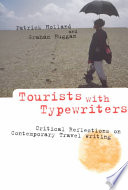Patrick Holland and Graham Huggin, Tourists with Typewriters: Critical Reflections on Contemporary Travel Writing (1998)
In preparation for writing a book about travel, I’m reading a lot of travel books. In preparation for that, I read Tourists with Typewriters, one of the few books of critical analysis of the travel genre. The focus is on contemporary travel writing, which for Huggan and Holland means the latter half of the twentieth century.
Intelligent but sometimes muddled, Tourists with Typewriters never quite lives up to the witty promise of its title. It’s very much a book of its time. Published in the same year that I finished my first travels in India and Nepal, it freights itself with the word “millennium,” goes for a swim in the murky waters of a poorly articulated postmodernism, and takes breathless notice of an internet just beginning to transform everything about travel.
Still, it has much to offer if you’re about to take a deep dive into travel writing’s greatest hits, with trenchant looks at everyone from Theroux and Chatwin to Naipaul and Iyer. In a chapter on post-colonial writing, Huggan and Holland throw some good punches at the anachronistic British white males bumbling about in embarrassed nostalgia for empire, and also at some of the writers from the colonies who seem interested more in indicting Western culture than in talking about real people and places. Following that, a chapter on “zones” takes a look at the recurring tropes in writing about the tropics, the Orient (mainly Japan), the South Seas, and the arctic. While South Asia doesn’t make the list, the analyses of these other zones is fair warning that any travel book is in danger of reaching for easy cliches. It was this chapter, more than anything else, than made it clear to me how necessary it would be to read the heavy hitters on India — Naipaul, Dalrymple, Tulley, Sukhetu Mehta — if only to avoid unknowingly repeating them. After all, my image of India was shaped not just by personal experience, but by The Lonely Planet, which in turn was shaped by received ideas about India. It’s not that one must never repeat anything another author has said — the Taj Mahal was beautiful when I went there, even if others had already said so — but that one should understand the tropes and framings that animate the works of others and make a conscious decision about whether to echo or counter them.
Things get more difficult in a chapter called “Gender and Other Troubles,” which runs into what I think of as the gay traveler’s paradox: that for a Western male traveler, fucking the locals is exploitive if they’re women but liberatory if they’re men. To be fair, Tourists with Typewriters was written before intersectionality became a watchword, but it’s still a startling oversight. You could make the case, I suppose, that there’s a difference in what it means to be a woman engaged with a foreigner and a man engaged with a foreigner, and that this difference is decisive — men, for example, may have more local power, and aren’t at risk of pregnancy — but no such case is ever made. There does seem to be an argument that gay men, more than straight men, are traveling in search of opportunities for legitimate sexual expression that have to be suppressed at home, but this too is suspect when you’re talking about men leaving behind, say, Britain of the fifties for the South Pacific. Why should the gay escape from prudery be privileged? And why shouldn’t gay travelers be held to account the way straight ones are for their unequal relationships?
The chapter on “postmodern itineraries” is as muddled and impenetrable as you would hope, and a final chapter, on travel writing at the millennium, is one of those adorably dated looks at an early internet in motion. Best not to say too much about them. Overall, Tourists with Typewriters is useful both as a window into what is considered travel writing serious enough to review, and into some of the more common pitfalls of such writing.

